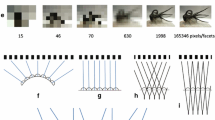Summary
The two fundamental limitations to resolving power of compound eyes are the wave (diffraction) and particle (photon noise) nature of light. By appreciating their interrelationship we gain insight into the design and limitation of eyes. In particular, we determine the dependence of eye design on the environmental light intensity.
-
1.
The limitations to resolving power include: the intensity of light, angular motion, receptor grain, lens-pupil blur, finite diameter of rhabdom, and neural convergence.
-
2.
Only those animals that are active in bright sunlight and normally have low angular velocity, profit by having some region of their eyes near the diffraction limit, i.e.DΔφ ≅ 0.58λ, whereD is the facet diameter,Δφ the interommatidial angle and λ the wavelength in vacuum. If these conditions are not fulfilled, it is better to have a largerDΔφ.
-
3.
The effect of an animal undergoing angular velocityu is equivalent to a reduction in light intensity by the amount exp−1.78(φtΔφ)2, where φt is the amount the animal turns in one integration time. Taking this into account, we present a possible explanation forMusca havingDΔφ about 4.5 times greater than the diffraction limit.
-
4.
Various strategies for dark-adaptation are considered with the conclusion that neural pooling combined with a widening of the acceptance angle is most effective for coping with reduced intensities.
Similar content being viewed by others
References
Barlow, H.B.: The size of ommatidia in apposition eyes. J. exp. Biol.29, 667–674 (1952)
Bracewell, R.: The Fourier transform and its applications. New York: McGraw-Hill 1965
Collett, T.S., Land, M.F.: Visual control of flight behaviour in the hoverfly,Syritta pipiens L. J. comp. Physiol.99, 1–66 (1975)
Fermi, G., Reichardt, W.: Optomotor reactions of the houseflyMusca domestica. Kybernetik2, 15 (1963)
Fox, R., Lumkuhle, S.W., Westendorf, D.H.: Falcon visual acuity. Science192, 263–265 (1976)
Goetz, K.G.: Optomotorische Untersuchung des visuellen Systems eines Augenmutanten der FruchtfliegeDrosophila. Kybernetik2, 77–86 (1964)
Goetz, K.G.: Die optischen Uebertragungseigenschaften der Komplexaugen vonDrosophila. Kybernetik2, 215–221 (1965)
Goodman, J.W.: Introduction to Fourier optics. New York: McGraw Hill 1968
Horridge, G.A.: Optical mechanisms of clear zone eyes. In: The compound eye and vision of insects (ed. G. A. Horridge). Oxford: Clarendon Press 1975
Horridge, G. A.: Looking at insect eyes. Sci. Amer. (1976)
Kirschfeld, K.: The absolute sensitivity of lens and compound eyes. Z. Naturforsch.29c, 592–596 (1974)
Kirschfeld, K.: The resolution of lens and compound eyes. In: Neural processing in visual systems (F. Zettler, R. Weiler, eds.). Berlin-Heidelberg-New York: Springer 1976
Kirschfeld, K., Franceschini, N.: Optische Eigenschaften der Ommatidien im Komplexauge vonMusca. Kybernetik6, 47–52 (1968)
Kirschfeld, K., Wenk, P.: The dorsal eye of sinuliid flies. Naturforsch. In press (1976)
Kuiper, J.W.: On the image formation in a single ommatidium of the compound eye in Diptera. In: The functional organization of the compound eye (C.G. Bernhard, ed.), pp. 35–50. Oxford: Pergamon Press 1966
Land, M.F., Collett, T.S.: Chasing behaviour of houseflies (Fannia canicularis). J. comp. Physiol.89, 331–357 (1974)
Laughlin, S.B.: Receptor function in the apposition eye. An electrophysical approach. In: Photoreceptor optics (A.W. Snyder, R. Menzel, eds.), pp. 479–498. Berlin-Heidelberg-New York: Springer 1975
Le Grand, Y.: Light, colour and vision, second ed., p. 84. London: Shapman and Hall 1968
Mallock, A.: Proc. roy. Soc.B55, p. 85 (1894)
Mallock, A.: Divided composite eyes. Nature (Lond.)110, 770–771 (1922)
Mazokhin-Porshnyakov, G.A.: Insect vision. New York: Plenum Press 1969
Petersen, D.P., Middleton, D.: Sampling and reconstruction of wave number limed functions inN-dimensional euclidean spaces. Information and control5, 279–293 (1962)
Portillo, J. del: Beziehungen zwischen Öffnungswinkeln der Ommatidien, Krümmung und Gestalt der Insekten-Augen und ihrer funktionellen Aufgabe. Z. vergl. Physiol.23, 100–145 (1936)
Rose, A.: Vision, human and electronic. New York-London: Plenum Press 1973
Sherk, T.E.: Development of the compound eyes of dragonflies (Odonata). To be submitted (1976)
Snyder, A.W.: The physics of vision in compound eyes. In: Handbook of sensory physiology. Vol. VII/6A,Invertebrates-photoreceptor organs (H. Autrum, ed.). Berlin-Heidelberg-New York: Springer 1977
Snyder, A.W., Laughlin, S.B., Stavenga, D.G.: Information capacity of eyes. Vision Res., in press (1977)
Snyder, A.W., Stavenga, D.G., Laughlin, S.B.: Spatial information capacity of compound eyes. J. comp. Physiol.116, 183–207 (1977)
Srinivansan, M.V., Bernard, G.D.: The effect of motion on visual acuity of the compound eye: A theoretical analysis. Vision Res.15, 515–525 (1975)
Stavenga, D.G.: Optical qualities of the fly eye-An approach from the side of geometrical, physical and waveguide optics. In: Photoreceptor optics (A. W. Snyder, ed.), pp. 126–144. Berlin-Heidelberg-New York: Springer 1975
Tunstall, J., Horridge, G.A.: Electrophysiological investigation of the optics of the locust retina. Z. vergl. Physiol.55, 167 (1967)
Vries, H. de: Physical aspects of the sense organs. Progr. Biophys.6, 208–264 (1956)
Wallcott, B.: Anatomical changes during light adaptation in insect eyes. In: The compound eyes and vision of insects (G. A. Horridge, ed.). London: Oxford Press 1975
Wyszeckiv, G., Stiles, W.S.: Color science concepts and methods, quantitative data and formula. New York: John Wiley 1967
Author information
Authors and Affiliations
Rights and permissions
About this article
Cite this article
Snyder, A.W. Acuity of compound eyes: Physical limitations and design. J. Comp. Physiol. 116, 161–182 (1977). https://doi.org/10.1007/BF00605401
Received:
Issue Date:
DOI: https://doi.org/10.1007/BF00605401




